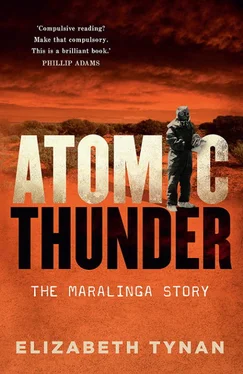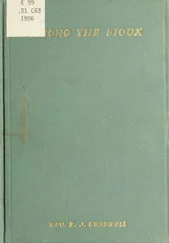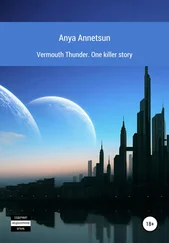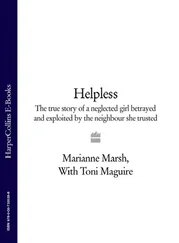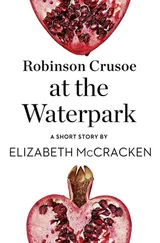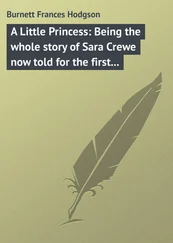Investigative journalists have begun sniffing around, including Howard Conkey and Paul Malone from the Canberra Times . Conkey writes to Walsh in June 1984 seeking clarification on the contaminated material found by the ARL team. Walsh replies on 28 June, ‘The present concerns with the newly identified fragments arise from the recognition that this material could be moved from its present site in an uncontrolled way (for example, picked up in the tyre tread of a motor vehicle)’.
At Maralinga, in that mild desert May of 1984, the scientists have been amazed and shocked at their findings. Over time they will become a little angry as well, particularly when their senior colleague John Moroney crunches the Roller Coaster data in the early 1990s. Williams, Burns and Moroney will be sources for Ian Anderson’s landmark story in New Scientist in 1993 on the British deceit about contamination at Maralinga. His role in the Anderson story will be Moroney’s last act in relation to Maralinga – within days of the story he will die from multiple myeloma. In the end, science, journalism, politics and the anger of veterans will all play a role in uncovering the shadowy Cold War story of the Maralinga desert nuclear test range. To find out how we got to this point, we need to go back to the birth of atomic weaponry.
2
Britain’s stealthy march towards the bomb
I’d learned by the bitter path that to touch the pitch of secrecy was to be contaminated for a very long time, that governments and politicians wanted not men who believed in the integrity of natural knowledge but men who would tell them what they want to hear, and that the truth has no meaning for a Churchill… [or] a Menzies, if it is politically inconvenient.
Professor Marcus (Mark) Oliphant, Australian physicist, 1956.
Secrecy was not only a guard against enemies but a barrier between allies. It caused much wartime ill-will between Britain and the United States.
Margaret Gowing, official historian of the British nuclear energy and weapons development programs, 1978.
‘Now I am become death, destroyer of worlds.’
J Robert Oppenheimer, physicist and leader of the Manhattan Project, quoting from Hindu scripture, as the first atomic weapon was tested at Alamogordo, New Mexico, 1945.
Britain came to the red sand of Maralinga through a series of contingent events. These ranged over politics and geography, colonial legacies and scientific pragmatism. One of the most significant factors was Britain’s early dominance in nuclear weapons development. Britain incubated the atomic bomb. Although she quickly lost custody to the US, Britain’s strong and distinguished tradition of physics research was the foundation for the terrifying weapons that shook the world and reshaped geopolitics after World War II.
British scientific history lays claim to some of the greatest minds in the field, including the father of modern physics, Sir Isaac Newton. At prolific laboratories, such as the Cavendish Laboratory at Cambridge University and the Department of Physics at the University of Birmingham, modern nuclear physics had some of its greatest advances. This is, after all, a story about physics as much as anything else, because physics made nuclear weaponry possible. Many physicists were later conflicted by this, first when atomic weapons killed tens of thousands of Japanese civilians and then when the weapons grew in strength and number until they could destroy our planet many times over.
British physicists were involved at all levels of the push to build the bomb. The country also welcomed and protected many Jewish physicists escaping persecution in Nazi Germany. These refugees found their professional contributions and lives were valued, working with colleagues on this most secret and challenging of problems. Physicists working in Britain drew together the disparate strands from the burgeoning field of nuclear physics – particularly essential research conducted in Paris just before the war – and came up with an ominous synthesis. In short, British physics initially powered the US Manhattan Project, the staggering scientific and technological effort that took just six years to develop the atomic bomb that was loaded into the bomb-bay of an operational aircraft in August 1945.
To understand the British tests in Australia we need to understand the British role in the Manhattan Project. The project drew upon substantial American expertise and technical wizardry, but the British provided the early intellectual boost. Tube Alloys, the world’s first atomic weapon development program, exemplified the British approach to developing the bomb. It buried a world-changing scientific research project under an obfuscating and boring bureaucratic name. The Tube Alloys Directorate was established in September 1941, and it continued after the war in several different guises. The secret research and development organisation with its deliberately misleading title quietly worked in a series of nondescript university laboratories and, later, dingy industrial workshops. No big, expensive infrastructure was involved. The can-do and well-funded Americans made the first operational bomb on the back of some remarkable work done on a shoestring in Britain under the banner of Tube Alloys and the Maud Committee that predated it. Debate still rages over whether this was a good thing or not, but either way it happened. The rapid-fire research of the Tube Alloys Directorate was transferred to the US, where it continued on to a dramatic conclusion under a far more recognisable name, the Manhattan Project.
The Manhattan Project changed the world. On 6 August 1945, this secret wartime project came to fruition in the most shocking way when the first atomic bomb was dropped on Hiroshima, followed, three days later, by a different kind of atomic bomb on Nagasaki. Exact figures are disputed, but at least 185 000 people died, either immediately or in the months directly after. Single bombs have never created so many casualties. The physics that enabled this broad-scale killing emerged at the beginning of the war; the atomic bombs played a role in ending it.
At the beginning of World War II the US president Franklin Roosevelt received an exceptionally important letter signed by Albert Einstein, the world’s best known and possibly greatest physicist. Leo Szilard and Eugene Wigner, both European refugee physicists based in the US, had drafted this epochal missive. The letter urged the president to investigate a totally new kind of bomb, a weapon that would exploit the process of nuclear fission, later known to many as splitting the atom. The atom to be split was from the remarkable element uranium.
This idea had gained its theoretical underpinnings in the late 1930s, so the science was new and almost entirely untested. Like a nuclear chain reaction, though, knowledge began exploding out of the initial idea. As noted by Margaret Gowing, the great historian of British atomic science, between January and June of 1939 over 20 papers were published on uranium in the prominent journal Nature alone. Military secrecy soon closed down publication as the work was recognised as strategically valuable and dangerous. But, for a while, an army of nuclear physicists, who saw what power might be unlocked by breaking the forces holding a uranium atom together, joined the frenzy to share their results.
Uranium, nature’s ‘heaviest’ element (that is, with the most matter in its nucleus), had virtually no practical use before 1938 when the Berlin-based German scientists Otto Hahn and Fritz Strassmann formulated a theory of nuclear fission that exploited its unique properties. Hahn, a chemist, built upon theoretical work he had done with the Austrian physicist Lise Meitner the year before and also on research in Paris that established basic understanding of how a uranium atom could be split and what happened when it was. Uranium was already known to bristle with many more neutrons than protons, but the Paris group showed that uranium atoms fling out some of the extra neutrons when they are ‘split’. At first the Hahn–Strassmann theory held only intellectual interest, because no-one thought that the energy produced by cleaving an atom could be harnessed and controlled. Nevertheless, the theory led quickly to related ideas of chain reaction and critical mass, explained below, that would, in a practical sense, make a bomb possible. Niels Bohr and John Wheeler published a memorandum on the fission process just three days before the outbreak of the war in Europe that gave scientific impetus to the notion of a nuclear weapon. This, according to Gowing, effectively ‘put all belligerents at the same theoretical starting point in the pursuit of an atomic bomb’.
Читать дальше
